headlamp MITSUBISHI ASX 2014 (in English) Owner's Guide
[x] Cancel search | Manufacturer: MITSUBISHI, Model Year: 2014, Model line: ASX, Model: MITSUBISHI ASX 2014Pages: 418, PDF Size: 14.02 MB
Page 215 of 418
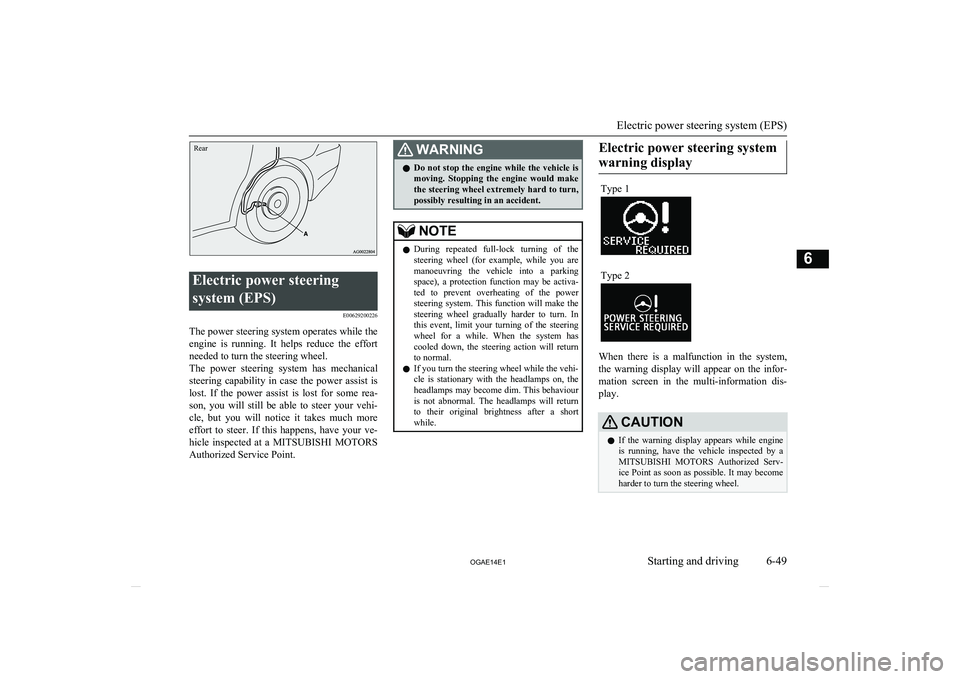
Rear
Electric power steeringsystem (EPS) E00629200226
The power steering system operates while theengine is running. It helps reduce the effort
needed to turn the steering wheel.
The power steering system has mechanical
steering capability in case the power assist is lost. If the power assist is lost for some rea-
son, you will still be able to steer your vehi-
cle, but you will notice it takes much more effort to steer. If this happens, have your ve-hicle inspected at a MITSUBISHI MOTORS
Authorized Service Point.
WARNINGl Do not stop the engine while the vehicle is
moving. Stopping the engine would make the steering wheel extremely hard to turn,
possibly resulting in an accident.NOTEl During repeated full-lock turning of the
steering wheel (for example, while you are manoeuvring the vehicle into a parking space), a protection function may be activa-
ted to prevent overheating of the power steering system. This function will make the
steering wheel gradually harder to turn. In
this event, limit your turning of the steering wheel for a while. When the system has
cooled down, the steering action will return to normal.
l If you turn the steering wheel while the vehi-
cle is stationary with the headlamps on, the
headlamps may become dim. This behaviour is not abnormal. The headlamps will returnto their original brightness after a shortwhile.Electric power steering system
warning displayType 1Type 2
When there is a malfunction in the system, the warning display will appear on the infor-
mation screen in the multi-information dis-
play.
CAUTIONl If the warning display appears while engine
is running, have the vehicle inspected by a
MITSUBISHI MOTORS Authorized Serv-
ice Point as soon as possible. It may become
harder to turn the steering wheel.
Electric power steering system (EPS)
6-49
OGAE14E1Starting and driving6
Page 229 of 418
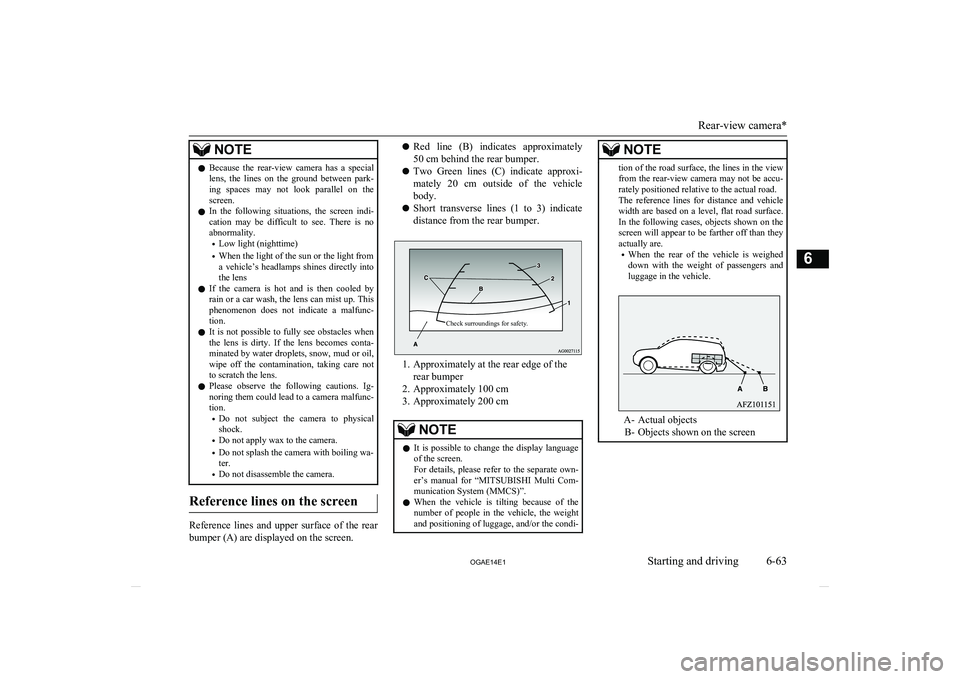
NOTElBecause the rear-view camera has a special
lens, the lines on the ground between park-
ing spaces may not look parallel on the screen.
l In the following situations, the screen indi-
cation may be difficult to see. There is no abnormality.
• Low light (nighttime)
• When the light of the sun or the light from
a vehicle’s headlamps shines directly into the lens
l If the camera is hot and is then cooled by
rain or a car wash, the lens can mist up. This phenomenon does not indicate a malfunc-
tion.
l It is not possible to fully see obstacles when
the lens is dirty. If the lens becomes conta-
minated by water droplets, snow, mud or oil, wipe off the contamination, taking care not
to scratch the lens.
l Please observe the following cautions. Ig-
noring them could lead to a camera malfunc-tion.
• Do not subject the camera to physical
shock.
• Do not apply wax to the camera.
• Do not splash the camera with boiling wa-
ter.
• Do not disassemble the camera.
Reference lines on the screen
Reference lines and upper surface of the rear
bumper (A) are displayed on the screen.
l Red line (B) indicates approximately
50 cm behind the rear bumper.
l Two Green lines (C) indicate approxi-
mately 20 cm outside of the vehicle body.
l Short transverse lines (1 to 3) indicate
distance from the rear bumper.Check surroundings for safety.
1. Approximately at the rear edge of the rear bumper
2. Approximately 100 cm
3. Approximately 200 cm
NOTEl It is possible to change the display language
of the screen.
For details, please refer to the separate own- er’s manual for “ MITSUBISHI Multi Com-
munication System (MMCS)”.
l When the vehicle is tilting because of the
number of people in the vehicle, the weight
and positioning of luggage, and/or the condi-NOTEtion of the road surface, the lines in the view from the rear-view camera may not be accu-
rately positioned relative to the actual road.
The reference lines for distance and vehicle
width are based on a level, flat road surface. In the following cases, objects shown on the
screen will appear to be farther off than they actually are.
• When the rear of the vehicle is weighed
down with the weight of passengers and
luggage in the vehicle.
A- Actual objects
B- Objects shown on the screen
Rear-view camera*
6-63
OGAE14E1Starting and driving6
Page 356 of 418
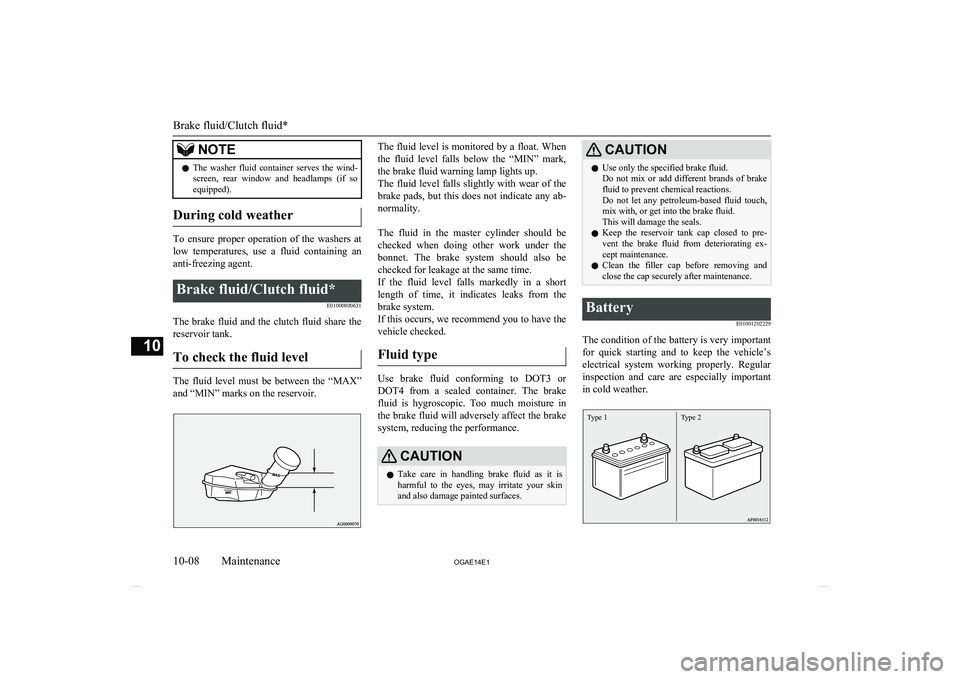
NOTElThe washer fluid container serves the wind-
screen, rear window and headlamps (if soequipped).
During cold weather
To ensure proper operation of the washers at
low temperatures, use a fluid containing ananti-freezing agent.
Brake fluid/Clutch fluid*
E01000800631
The brake fluid and the clutch fluid share thereservoir tank.
To check the fluid level
The fluid level must be between the “MAX” and “MIN” marks on the reservoir.
The fluid level is monitored by a float. When
the fluid level falls below the “MIN” mark, the brake fluid warning lamp lights up.The fluid level falls slightly with wear of the brake pads, but this does not indicate any ab-
normality.
The fluid in the master cylinder should be checked when doing other work under thebonnet. The brake system should also be checked for leakage at the same time.
If the fluid level falls markedly in a short length of time, it indicates leaks from the
brake system.
If this occurs, we recommend you to have the
vehicle checked.
Fluid type
Use brake fluid conforming to DOT3 or DOT4 from a sealed container. The brake
fluid is hygroscopic. Too much moisture in the brake fluid will adversely affect the brake
system, reducing the performance.
CAUTIONl Take care in handling brake fluid as it is
harmful to the eyes, may irritate your skin
and also damage painted surfaces.CAUTIONl Use only the specified brake fluid.
Do not mix or add different brands of brake fluid to prevent chemical reactions.
Do not let any petroleum-based fluid touch, mix with, or get into the brake fluid.
This will damage the seals.
l Keep the reservoir tank cap closed to pre-
vent the brake fluid from deteriorating ex- cept maintenance.
l Clean the filler cap before removing and
close the cap securely after maintenance.Battery
E01001202229
The condition of the battery is very important
for quick starting and to keep the vehicle’s electrical system working properly. Regularinspection and care are especially importantin cold weather.
Type 1Type 2
Brake fluid/Clutch fluid*
10-08 OGAE14E1Maintenance10
Page 371 of 418
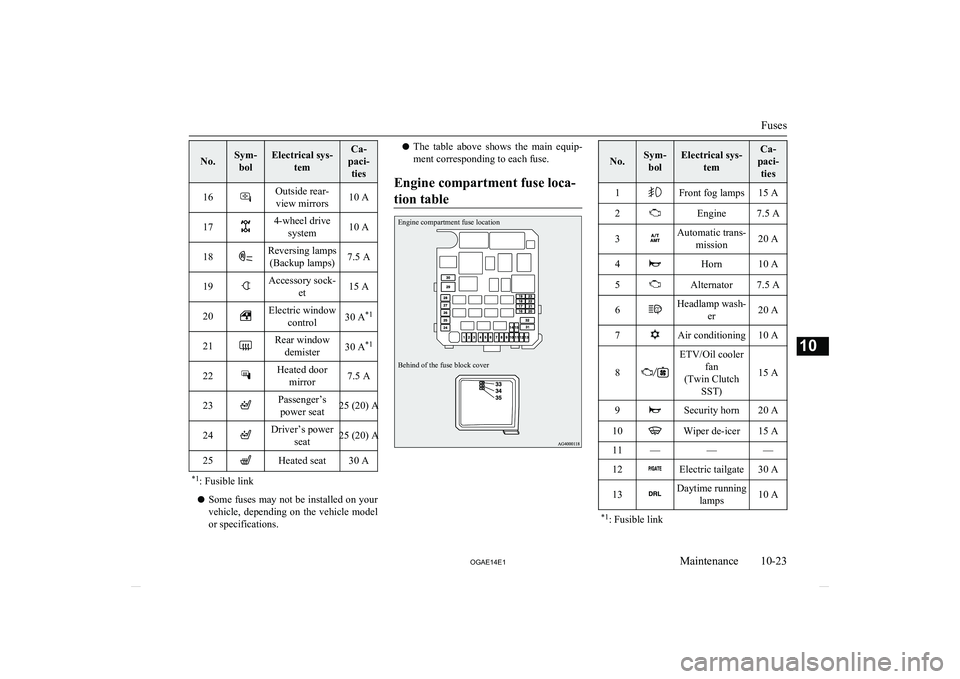
No.Sym-bolElectrical sys- temCa-
paci- ties16Outside rear-view mirrors10 A174-wheel drive system10 A18Reversing lamps(Backup lamps)7.5 A19Accessory sock- et15 A20Electric windowcontrol30 A *121Rear window
demister30 A *122Heated door
mirror7.5 A23Passenger’spower seat25 (20) A24Driver’s power seat25 (20) A25Heated seat30 A*1: Fusible link
l Some fuses may not be installed on your
vehicle, depending on the vehicle model
or specifications.
l The table above shows the main equip-
ment corresponding to each fuse.
Engine compartment fuse loca- tion tableEngine compartment fuse locationBehind of the fuse block cover
No.Sym- bolElectrical sys- temCa-
paci- ties1Front fog lamps15 A2Engine7.5 A3Automatic trans- mission20 A4Horn10 A5Alternator7.5 A6Headlamp wash- er20 A7Air conditioning10 A
8
ETV/Oil coolerfan
(Twin Clutch SST)
15 A
9Security horn20 A10Wiper de-icer15 A11———12Electric tailgate30 A13Daytime running lamps10 A*1: Fusible link
Fuses
10-23
OGAE14E1Maintenance10
Page 372 of 418
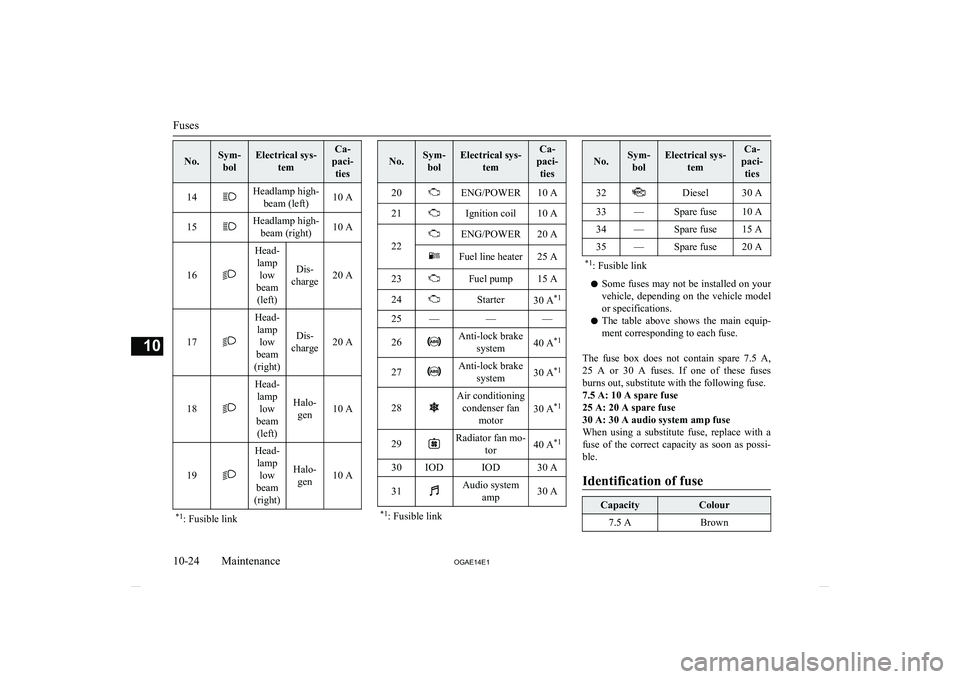
No.Sym-bolElectrical sys- temCa-
paci- ties14Headlamp high- beam (left)10 A15Headlamp high-beam (right)10 A
16
Head-lamp low
beam (left)
Dis-
charge20 A17
Head- lamp low
beam
(right)
Dis-
charge20 A18
Head- lamp low
beam (left)
Halo- gen10 A19
Head-lamp low
beam
(right)
Halo- gen10 A
*1 : Fusible link
No.Sym-
bolElectrical sys- temCa-
paci- ties20ENG/POWER10 A21Ignition coil10 A
22
ENG/POWER20 AFuel line heater25 A23Fuel pump15 A24Starter30 A *125———26Anti-lock brake
system40 A *127Anti-lock brake
system30 A *128
Air conditioning
condenser fan motor
30 A *129Radiator fan mo-
tor40 A*130IODIOD30 A31Audio system
amp30 A*1: Fusible link
No.Sym-
bolElectrical sys- temCa-
paci- ties32Diesel30 A33—Spare fuse10 A34—Spare fuse15 A35—Spare fuse20 A*1 : Fusible link
l Some fuses may not be installed on your
vehicle, depending on the vehicle model
or specifications.
l The table above shows the main equip-
ment corresponding to each fuse.
The fuse box does not contain spare 7.5 A ,
25 A or 30 A fuses. If one of these fuses burns out, substitute with the following fuse.7.5 A: 10 A spare fuse
25 A: 20 A spare fuse
30 A: 30 A audio system amp fuse
When using a substitute fuse, replace with a
fuse of the correct capacity as soon as possi- ble.
Identification of fuse
CapacityColour7.5 ABrown
Fuses
10-24 OGAE14E1Maintenance10
Page 374 of 418
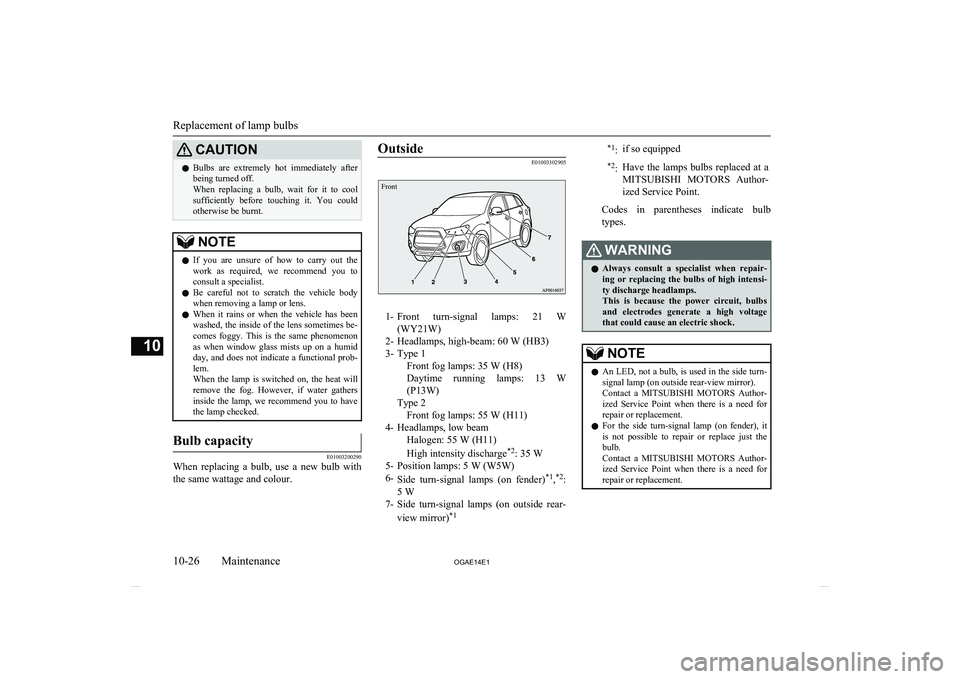
CAUTIONlBulbs are extremely hot immediately after
being turned off.
When replacing a bulb, wait for it to cool
sufficiently before touching it. You could otherwise be burnt.NOTEl If you are unsure of how to carry out the
work as required, we recommend you to consult a specialist.
l Be careful not to scratch the vehicle body
when removing a lamp or lens.
l When it rains or when the vehicle has been
washed, the inside of the lens sometimes be-
comes foggy. This is the same phenomenon as when window glass mists up on a humid
day, and does not indicate a functional prob- lem.
When the lamp is switched on, the heat will
remove the fog. However, if water gathers inside the lamp, we recommend you to havethe lamp checked.Bulb capacity
E01003200290
When replacing a bulb, use a new bulb with
the same wattage and colour.
Outside
E01003302905
Front
1- Front turn-signal lamps: 21 W
(WY21W)
2- Headlamps, high-beam: 60 W (HB3) 3- Type 1 Front fog lamps: 35 W (H8)
Daytime running lamps: 13 W
(P13W)
Type 2 Front fog lamps: 55 W (H11)
4- Headlamps, low beam
Halogen: 55 W (H11)
High intensity discharge *2
: 35 W
5- Position lamps: 5 W (W5W)
6- Side turn-signal lamps (on fender) *1
,*2
:
5 W
7- Side turn-signal lamps (on outside rear-
view mirror) *1
*1
:if so equipped*2:Have the lamps bulbs replaced at a
MITSUBISHI MOTORS Author-
ized Service Point.
Codes in parentheses indicate bulb types.
WARNINGl Always consult a specialist when repair-
ing or replacing the bulbs of high intensi- ty discharge headlamps.
This is because the power circuit, bulbs
and electrodes generate a high voltage
that could cause an electric shock.NOTEl An LED, not a bulb, is used in the side turn-
signal lamp (on outside rear-view mirror).
Contact a MITSUBISHI MOTORS Author-
ized Service Point when there is a need for
repair or replacement.
l For the side turn-signal lamp (on fender), it
is not possible to repair or replace just the bulb.
Contact a MITSUBISHI MOTORS Author-
ized Service Point when there is a need for
repair or replacement.
Replacement of lamp bulbs
10-26 OGAE14E1Maintenance10
Page 375 of 418
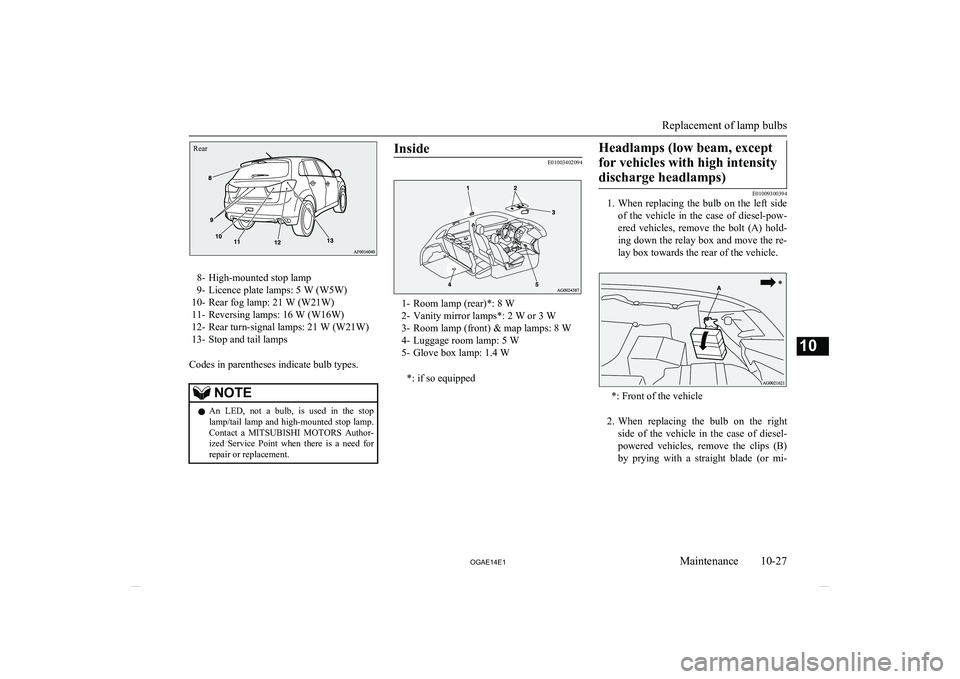
Rear
8- High-mounted stop lamp
9- Licence plate lamps: 5 W (W5W)
10- Rear fog lamp: 21 W (W21W)
11- Reversing lamps: 16 W (W16W)
12- Rear turn-signal lamps: 21 W (W21W) 13- Stop and tail lamps
Codes in parentheses indicate bulb types.
NOTEl An LED, not a bulb, is used in the stop
lamp/tail lamp and high-mounted stop lamp.
Contact a MITSUBISHI MOTORS Author-
ized Service Point when there is a need for
repair or replacement.Inside
E01003402094
1- Room lamp (rear)*: 8 W
2- Vanity mirror lamps*: 2 W or 3 W
3- Room lamp (front) & map lamps: 8 W
4- Luggage room lamp: 5 W
5- Glove box lamp: 1.4 W
*: if so equipped
Headlamps (low beam, exceptfor vehicles with high intensitydischarge headlamps)
E01009300394
1. When replacing the bulb on the left side
of the vehicle in the case of diesel-pow- ered vehicles, remove the bolt (A) hold-
ing down the relay box and move the re- lay box towards the rear of the vehicle.
*: Front of the vehicle
2. When replacing the bulb on the right
side of the vehicle in the case of diesel-
powered vehicles, remove the clips (B)
by prying with a straight blade (or mi-
Replacement of lamp bulbs
10-27
OGAE14E1Maintenance10
Page 376 of 418
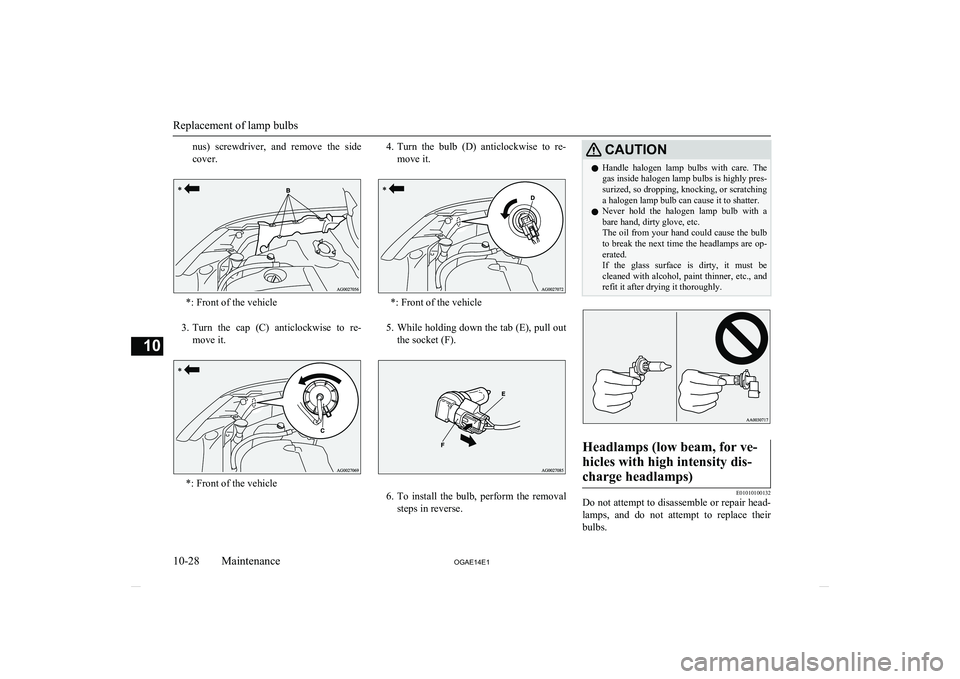
nus) screwdriver, and remove the sidecover.
*: Front of the vehicle
3. Turn the cap (C) anticlockwise to re-
move it.
*: Front of the vehicle
4. Turn the bulb (D) anticlockwise to re-
move it.
*: Front of the vehicle
5. While holding down the tab (E), pull out
the socket (F).
6. To install the bulb, perform the removal
steps in reverse.
CAUTIONl Handle halogen lamp bulbs with care. The
gas inside halogen lamp bulbs is highly pres-
surized, so dropping, knocking, or scratching
a halogen lamp bulb can cause it to shatter.
l Never hold the halogen lamp bulb with a
bare hand, dirty glove, etc.
The oil from your hand could cause the bulb to break the next time the headlamps are op-
erated.
If the glass surface is dirty, it must be cleaned with alcohol, paint thinner, etc., andrefit it after drying it thoroughly.Headlamps (low beam, for ve-
hicles with high intensity dis- charge headlamps)
E01010100132
Do not attempt to disassemble or repair head- lamps, and do not attempt to replace their
bulbs.
Replacement of lamp bulbs
10-28 OGAE14E1Maintenance10
Page 377 of 418
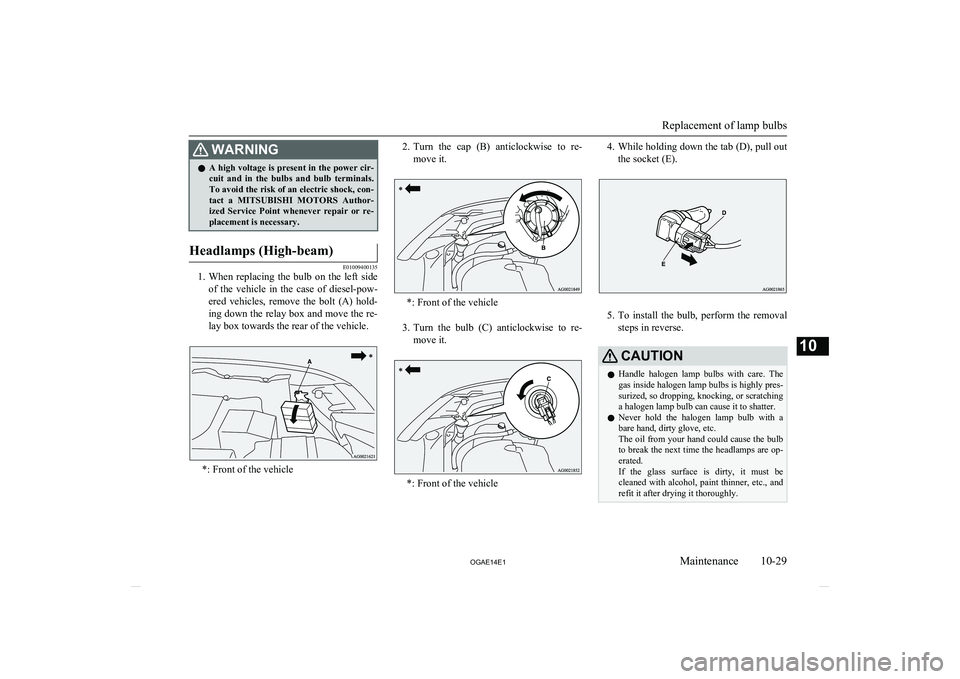
WARNINGlA high voltage is present in the power cir-
cuit and in the bulbs and bulb terminals.To avoid the risk of an electric shock, con-
tact a MITSUBISHI MOTORS Author-
ized Service Point whenever repair or re- placement is necessary.Headlamps (High-beam)
E01009400135
1. When replacing the bulb on the left side
of the vehicle in the case of diesel-pow-
ered vehicles, remove the bolt (A) hold-
ing down the relay box and move the re- lay box towards the rear of the vehicle.
*: Front of the vehicle
2. Turn the cap (B) anticlockwise to re-
move it.
*: Front of the vehicle
3. Turn the bulb (C) anticlockwise to re-
move it.
*: Front of the vehicle
4. While holding down the tab (D), pull out
the socket (E).
5. To install the bulb, perform the removal
steps in reverse.
CAUTIONl Handle halogen lamp bulbs with care. The
gas inside halogen lamp bulbs is highly pres- surized, so dropping, knocking, or scratching
a halogen lamp bulb can cause it to shatter.
l Never hold the halogen lamp bulb with a
bare hand, dirty glove, etc.
The oil from your hand could cause the bulb to break the next time the headlamps are op-
erated.
If the glass surface is dirty, it must be cleaned with alcohol, paint thinner, etc., and
refit it after drying it thoroughly.
Replacement of lamp bulbs
10-29
OGAE14E1Maintenance10
Page 403 of 418
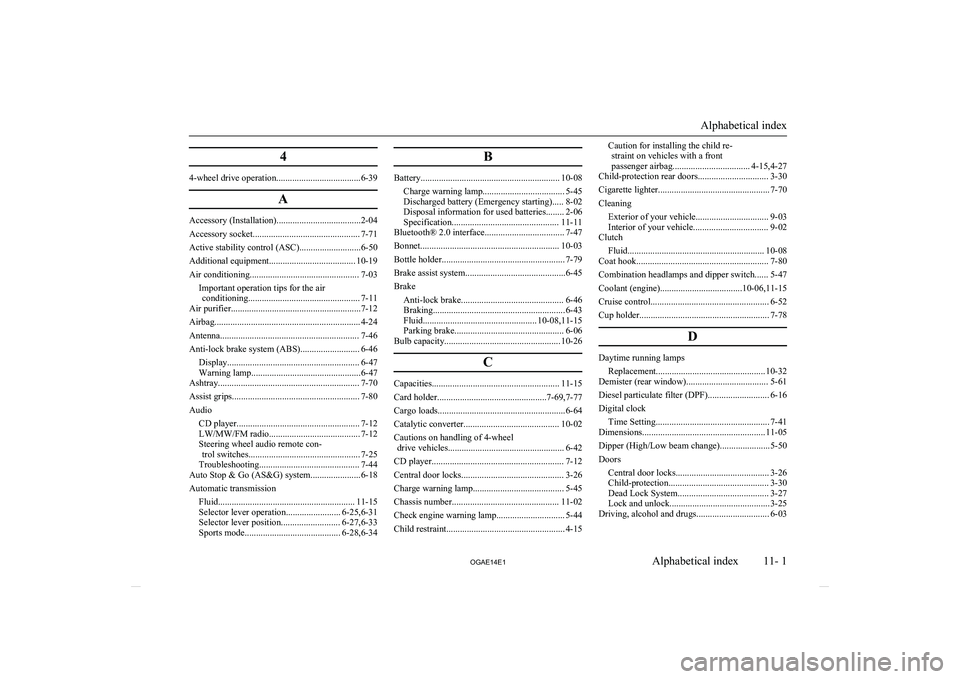
4
4-wheel drive operation.....................................6-39A
Accessory (Installation).....................................2-04
Accessory socket............................................... 7-71
Active stability control (ASC)...........................6-50
Additional equipment...................................... 10-19
Air conditioning................................................ 7-03 Important operation tips for the airconditioning................................................. 7-11
Air purifier.........................................................7-12
Airbag................................................................ 4-24
Antenna............................................................. 7-46
Anti-lock brake system (ABS).......................... 6-46 Display.......................................................... 6-47
Warning lamp................................................6-47
Ashtray.............................................................. 7-70
Assist grips........................................................ 7-80
Audio CD player...................................................... 7-12
LW/MW/FM radio........................................ 7-12
Steering wheel audio remote con- trol switches................................................. 7-25
Troubleshooting............................................ 7-44
Auto Stop & Go (AS&G) system......................6-18
Automatic transmission Fluid............................................................ 11-15
Selector lever operation........................ 6-25,6-31
Selector lever position.......................... 6-27,6-33
Sports mode.......................................... 6-28,6-34
B
Battery............................................................. 10-08
Charge warning lamp.................................... 5-45
Discharged battery (Emergency starting)..... 8-02
Disposal information for used batteries........ 2-06
Specification............................................... 11-11
Bluetooth® 2.0 interface................................... 7-47
Bonnet............................................................. 10-03
Bottle holder...................................................... 7-79
Brake assist system............................................6-45
Brake Anti-lock brake............................................. 6-46
Braking.......................................................... 6-43
Fluid.................................................. 10-08,11-15
Parking brake................................................ 6-06
Bulb capacity................................................... 10-26
C
Capacities........................................................ 11-15
Card holder................................................7-69,7-77
Cargo loads........................................................6-64
Catalytic converter.......................................... 10-02
Cautions on handling of 4-wheel drive vehicles................................................... 6-42
CD player.......................................................... 7-12
Central door locks............................................. 3-26
Charge warning lamp........................................ 5-45
Chassis number............................................... 11-02
Check engine warning lamp.............................. 5-44
Child restraint.................................................... 4-15
Caution for installing the child re- straint on vehicles with a front
passenger airbag.................................. 4-15,4-27
Child-protection rear doors............................... 3-30
Cigarette lighter................................................. 7-70
Cleaning
Exterior of your vehicle................................ 9-03
Interior of your vehicle................................. 9-02
Clutch
Fluid............................................................ 10-08
Coat hook.......................................................... 7-80
Combination headlamps and dipper switch...... 5-47
Coolant (engine)....................................10-06,11-15
Cruise control.................................................... 6-52
Cup holder......................................................... 7-78
D
Daytime running lampsReplacement................................................ 10-32
Demister (rear window).................................... 5-61
Diesel particulate filter (DPF)........................... 6-16Digital clock Time Setting.................................................. 7-41
Dimensions...................................................... 11-05
Dipper (High/Low beam change)......................5-50
Doors Central door locks......................................... 3-26Child-protection............................................ 3-30 Dead Lock System........................................ 3-27
Lock and unlock............................................ 3-25
Driving, alcohol and drugs................................ 6-03
Alphabetical index
11- 1
OGAE14E1Alphabetical index